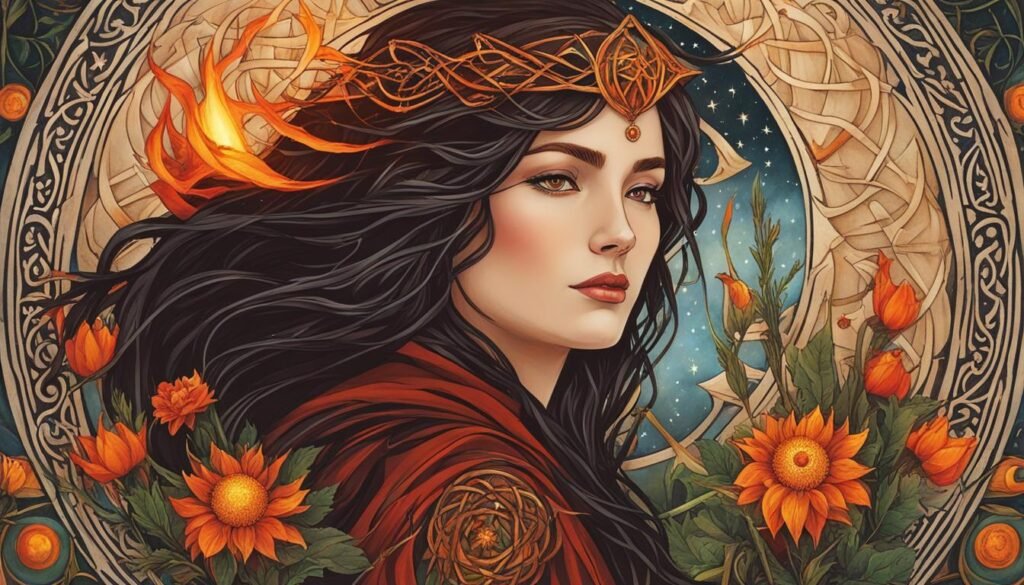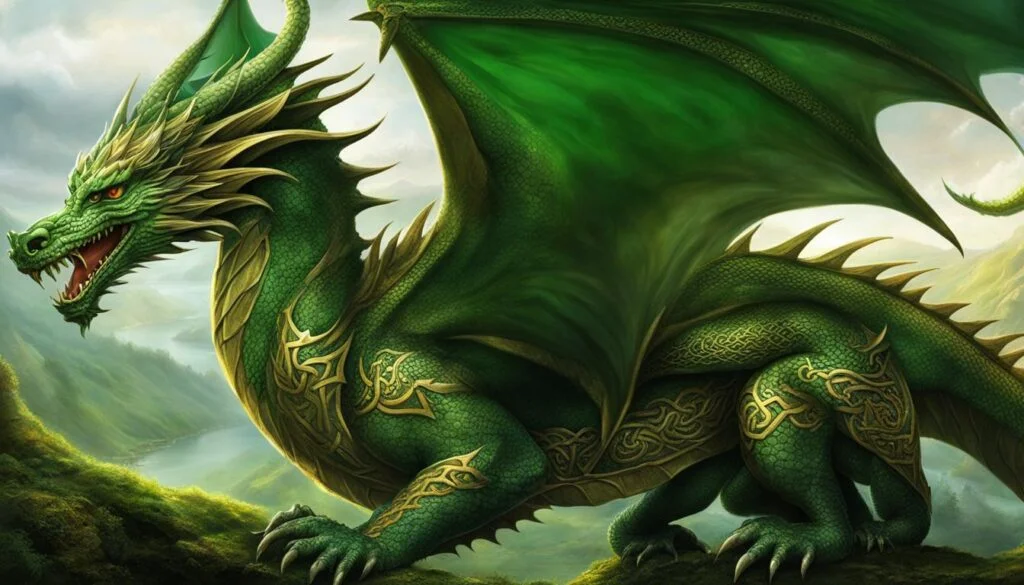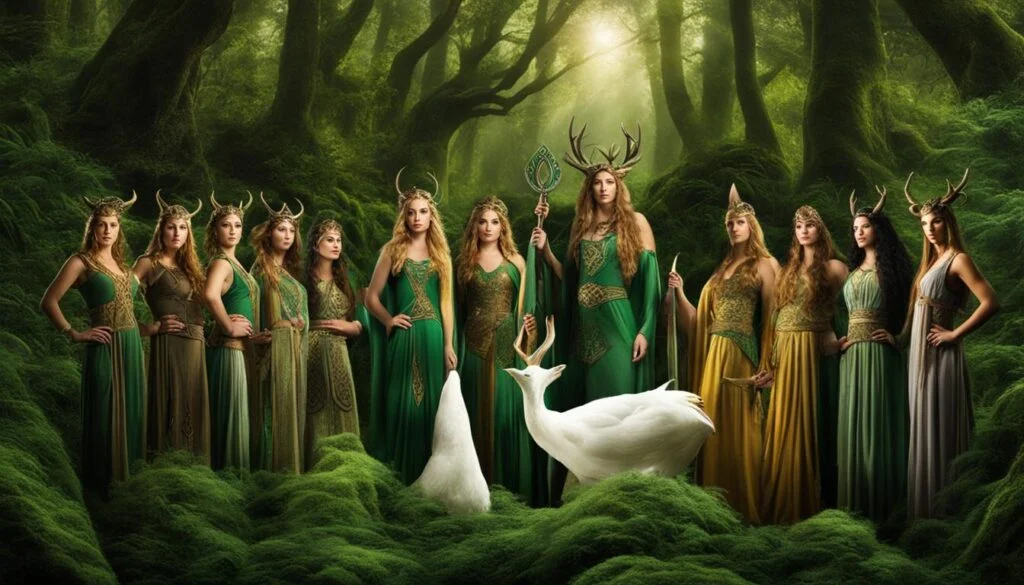Brigid is a revered figure in Celtic mythology, known for her multifaceted domains and profound significance. As a member of the Tuatha Dé Danann, Brigid is associated with wisdom, poetry, healing, protection, smithing, and the welfare of domesticated animals. She is believed to be the daughter of the Dagda, a chief deity in Celtic folklore, and may have been part of a triple deity alongside her sisters, Brigid the healer and Brigid the smith.
Key Takeaways:
- Brigid is a prominent figure in Celtic mythology, closely associated with wisdom, poetry, healing, protection, smithing, and the well-being of domesticated animals.
- She is believed to be the daughter of the Dagda, a revered deity in Celtic folklore.
- Brigid may have been part of a triple deity, often mentioned alongside her sisters Brigid the healer and Brigid the smith.
- Similarities can be drawn between Brigid and the Christian saint of the same name, Saint Brigid of Kildare, with her feast day originally being a pagan festival called Imbolc.
- Brigid’s influence extends beyond mythology, with her name and domains persisting in modern popular culture.
The Goddess Brigid in Irish Mythology
Brigid is a goddess of pre-Christian Ireland and is part of the Tuatha Dé Danann, a supernatural race in Irish mythology. She is the daughter of the Dagda, the chief deity of the Tuatha Dé Danann. Brigid’s domains include wisdom, poetry, healing, and protection. She is associated with the sun and fire, and is often depicted as a fiery-haired goddess. In Irish mythology, she is revered by poets and craftsmen alike and is considered a fount of innovation.
- Brigid is a goddess in Irish mythology.
- She is part of the Tuatha Dé Danann, a supernatural race.
- Her father is the Dagda, the chief deity of the Tuatha Dé Danann.
- Brigid’s domains include wisdom, poetry, healing, and protection.
- She is often depicted as a fiery-haired goddess.
- In Irish mythology, she is revered for her inspiration and innovative spirit.
Brigid’s Triple Aspects and Domains
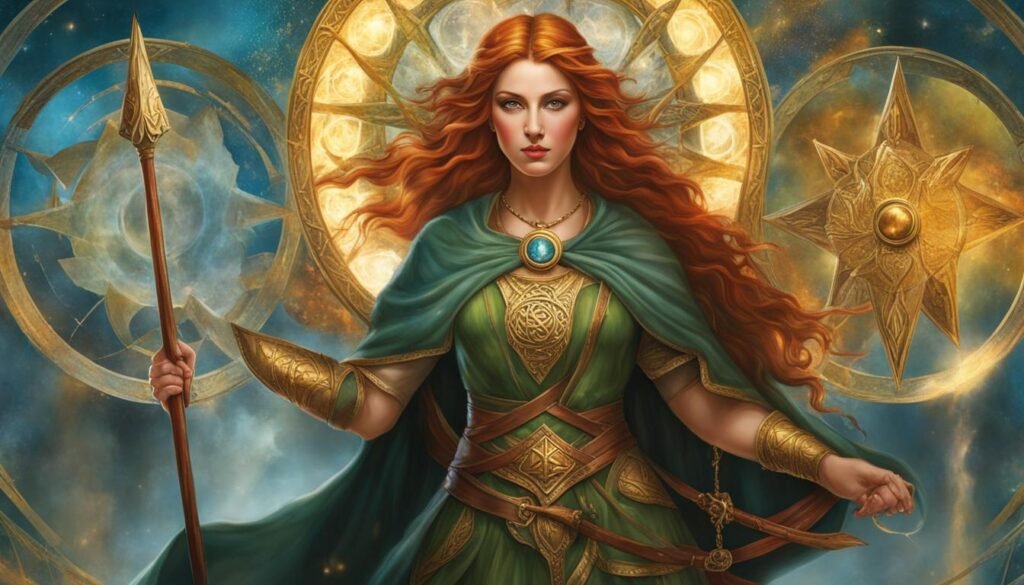
Brigid, the revered goddess of Celtic mythology, embodies a fascinating triple aspect. Often depicted as a triple deity with three sisters sharing the same name, Brigid represents wisdom and poetry, healing, and smithing. Let’s delve into each of her domains:
1. Wisdom and Poetry
Brigid is held in high regard by poets, as she is believed to be a source of inspiration and creativity. Her domain of wisdom encompasses not only knowledge but also the ability to communicate it through the art of poetry. She is revered as a muse, guiding poets on their creative journeys.
2. Healing
As a healer, Brigid possesses deep knowledge and profound skill in bringing about physical and emotional healing. She is associated with sacred wells, believed to possess powerful, rejuvenating properties. Those seeking healing often turn to Brigid, recognizing her as a compassionate and benevolent goddess.
3. Smithing
Brigid is also a master craftswoman, representing the art of blacksmithing. This domain connects her to the transformative power of fire, which is essential in the smithing process. Through smithing, Brigid symbolizes the ability to shape and mold not only metals but also the circumstances of one’s life.
Additionally, Brigid is strongly associated with the protection of domesticated animals, safeguarding their well-being. These diverse domains and aspects make Brigid a multidimensional goddess, revered for her wisdom, healing powers, craftsmanship, and guardianship.
Continue reading the article to explore the intriguing connections between Brigid and Saint Brigid, as well as the symbols and sacred sites related to this influential goddess.
Brigid in Relation to Saint Brigid
Historians suggest that the Celtic goddess Brigid was later syncretized with the Christian saint of the same name, Saint Brigid of Kildare. This syncretism occurred when Christian monks grafted the name and functions of the ancient goddess onto the saint. Both Brigid and Saint Brigid are associated with healing, poetry, blacksmithing, and the arrival of spring. The lore and traditions of the goddess were likely transferred to the saint, creating a connection between the two figures.
Brigid’s Symbols and Sacred Sites
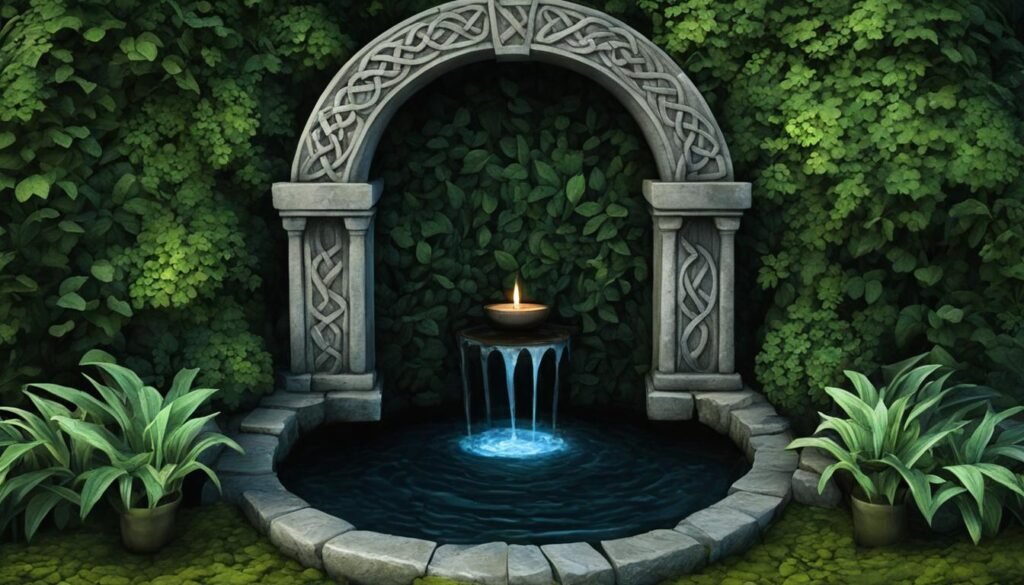
Brigid, the revered Celtic goddess, is associated with various symbols that hold deep significance in her mythology. Among these symbols are wells and the Brigid Cross, both of which play important roles in Celtic folklore.
Wells Dedicated to Brigid
Throughout Ireland and Scotland, numerous wells are dedicated to Brigid. These sacred sites are believed to possess healing properties and attract visitors seeking blessings of health and inspiration. Pilgrims have long traveled to these wells, seeking solace and rejuvenation in the waters associated with Brigid’s divine presence.
The healing properties attributed to Brigid’s wells stem from her role as a goddess of healing and protection. Her association with sacred waters underscores her connection to the natural world and her ability to bring about transformation and renewal.
The Brigid Cross
The Brigid Cross is a traditional symbol closely associated with Brigid and her protective powers. It is typically crafted from rushes or grass and is traditionally hung above doorways for protection against negative energies and malevolent spirits.
The Brigid Cross is characterized by its distinctive shape, consisting of four arms that intersect near their centers. The arms are often said to represent the four directions, the elements, or the seasons, symbolizing Brigid’s presence as a guiding force in all aspects of life.
By hanging the Brigid Cross, individuals seek Brigid’s blessings, invoking her power to safeguard their homes and loved ones. The symbol serves as a reminder of Brigid’s presence and her role as a protector and guardian.
Brigid’s symbols, including wells and the Brigid Cross, continue to hold deep spiritual and cultural significance today. They serve as tangible connections to the ancient Celtic traditions and the enduring legacy of this revered goddess.
Brigid’s Name and Etymology
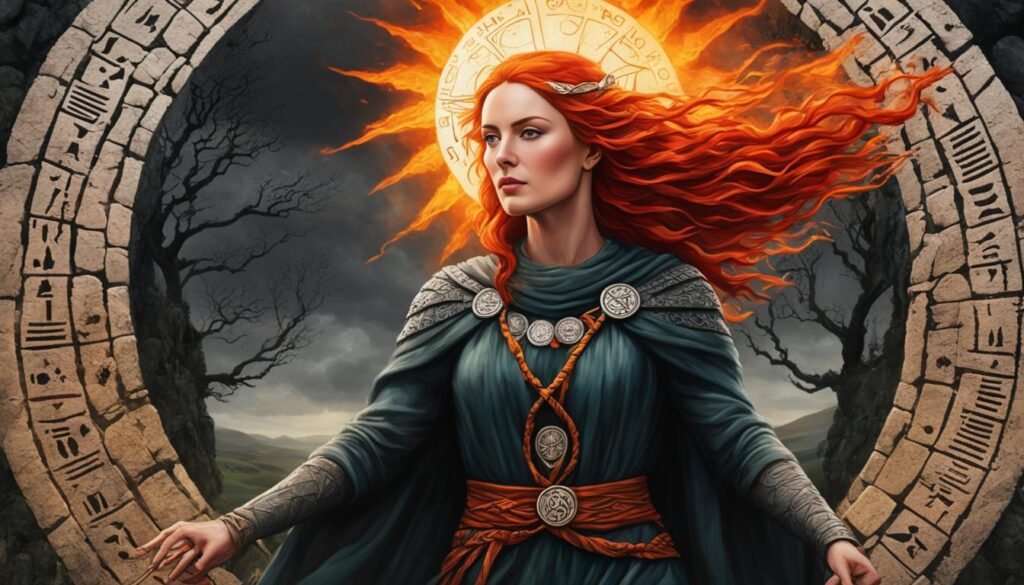
The name Brigid is derived from the Old Irish Brig, which means “exalted one” or “high one.” This name is believed to have originated from the Proto-Celtic word Briganti, which is associated with the ancient British goddess Brigantia. The name is also cognate with Old High German and Sanskrit words meaning “high.” The association with the Hindu dawn goddess Ushas suggests a possible connection to ancient dawn goddesses across different cultures.
Etymology of Brigid
- The name Brigid comes from the Old Irish Brig, meaning “exalted one” or “high one.”
- It is derived from the Proto-Celtic word Briganti, associated with the British goddess Brigantia.
- The name is cognate with Old High German and Sanskrit words meaning “high.”
- The connection to the Hindu dawn goddess Ushas suggests a potential link to dawn goddesses in other cultures.
Brigid’s Family and Mythological Connections
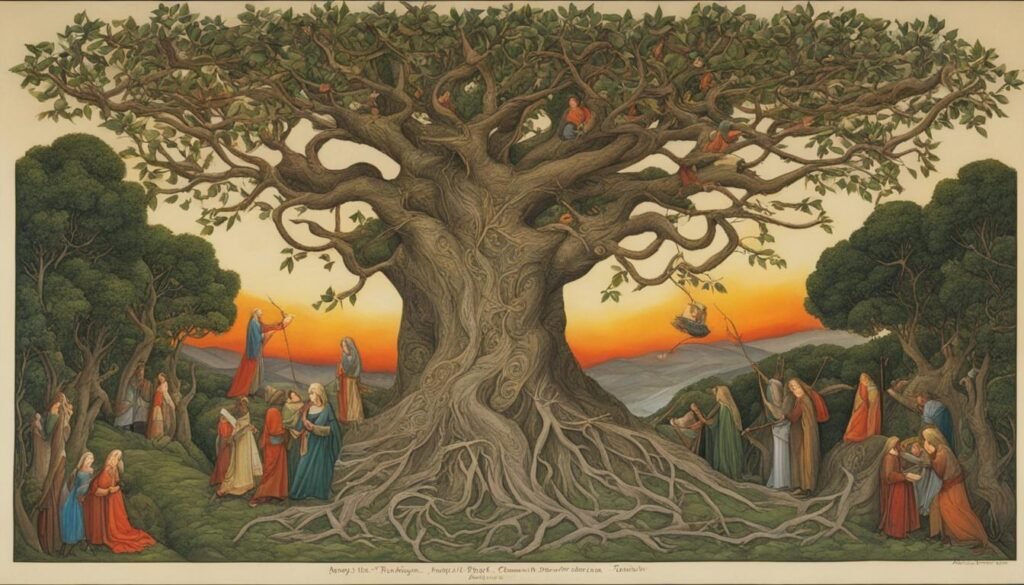
Brigid, a prominent figure in Celtic mythology and a member of the Tuatha Dé Danann, was the daughter of the Dagda, the chief deity of the Tuatha Dé Danann. She was a part of a large family and had several siblings, including Aengus, Midir, Bodb Derg, Cermait, and Aed. While the identity of Brigid’s mother remains unclear, some sources suggest a possible association with the goddess Danu, the namesake of the Tuatha Dé Danann.
Brigid’s familial connections highlight her importance within Celtic mythology and showcase the intricate relationships between mythological figures. As the daughter of the Dagda, Brigid inherits a significant lineage and is deeply rooted in the mythological lore of the Tuatha Dé Danann.
To better understand Brigid’s role and significance, it is essential to explore her family connections and their influence on her mythological portrayal. Through these connections, the complexity and depth of Brigid’s character and mythology become evident.
- The Dagda – Brigid’s father and the chief deity of the Tuatha Dé Danann.
- Aengus – Brigid’s sibling.
- Midir – Brigid’s sibling.
- Bodb Derg – Brigid’s sibling.
- Cermait – Brigid’s sibling.
- Aed – Brigid’s sibling.
The intricate web of relationships within Brigid’s family showcases the interconnected nature of Celtic mythology and highlights her significance within this rich mythological tradition.
Brigid’s Role in Celtic Mythology

Brigid serves as a significant bridge between humankind and the otherworld in Celtic mythology. Her presence is deeply intertwined with sacred sites, making her an integral figure in the spiritual landscape of Ireland. Revered by the druidic cults, Brigid was called upon for various purposes, embodying the connection between mortals and the divine.
As a protector, Brigid’s associations with fire and healing exemplify her role in safeguarding individuals and communities. Fire, a symbol of transformation, represents the cleansing and purifying aspects of Brigid’s power. Her connection to healing reflects her role in providing physical and spiritual wellness to those who seek her aid. Brigid’s affinity with domesticated animals further emphasizes her role as a guardian and nurturer.
Brigid’s influence is evident in the numerous sacred sites dedicated to her that dot the Irish landscape. These sites serve as physical manifestations of her powerful presence and are visited by individuals seeking her blessings and guidance. Brigid’s spirit is deeply ingrained in these locations, serving as a reminder of her enduring impact on Celtic mythology.
Brigid’s Dichotomy and Attributes
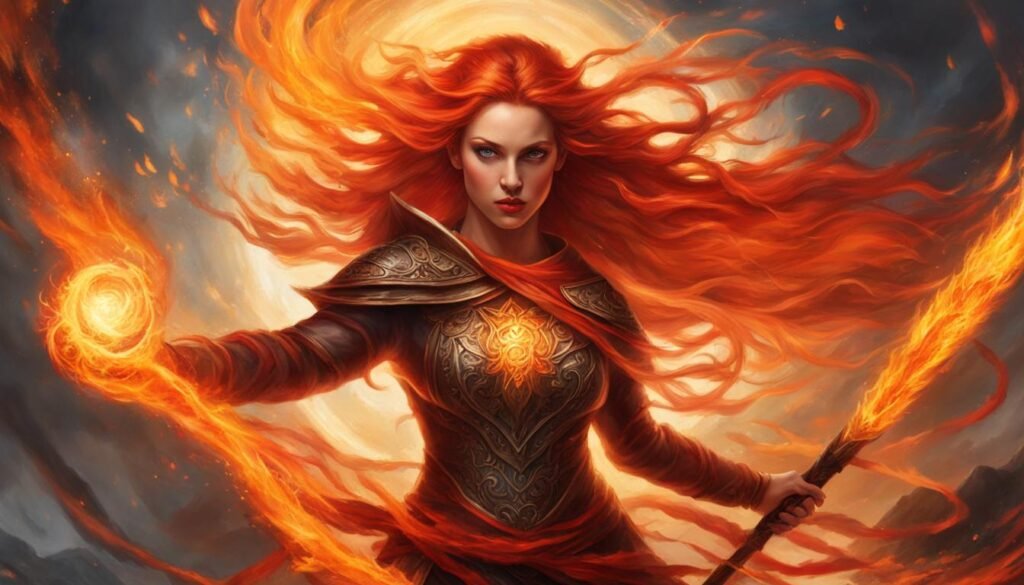
Brigid, the revered goddess of Celtic mythology, possesses a captivating dichotomy of attributes that define her multifaceted nature. She encompasses the essence of both a fiery goddess and a nurturing protector, embracing contrasting aspects of passion, fertility, healing, and domestication. Associated with the primal force of fire, Brigid ignites the flames of passion and symbolizes the fiery energy that fuels creativity and ignites inspiration.
As a fire goddess, Brigid embodies the transformative power of the flames, which symbolize purification, rebirth, and the eternal cycle of life. Her association with fire represents not only the intensity of passion and desire but also the metaphorical fire within that drives individuals to create and innovate.
However, Brigid’s domain extends beyond the realm of fire. She is also known as a protective deity, guarding and nurturing those in need. As a protector, she is closely linked to healing and takes on the role of a guardian for both humans and domesticated animals. Her compassionate and caring nature represents the aspect of Brigid that brings comfort and solace to those who seek her aid.
Brigid’s influence transcends her role as a fire goddess and protector. She is also revered as a goddess of poetry, inspiring and encouraging creativity in all its forms. Poets hold her in high esteem, seeking her divine inspiration to craft verses and capture the beauty and essence of the world through their words.
Furthermore, Brigid’s mythology emphasizes her remarkable ability to heal and bring about transformation. Ancient stories and legends depict her as a powerful healer, possessing deep knowledge and the will to mend both physical and spiritual wounds. Her healing touch emanates from a place of divine compassion, offering hope and restoration to those in need.
Brigid’s Dichotomy in Celtic Mythology:
- Fiery goddess associated with passion and fertility
- Protective deity and guardian of healing and domesticated animals
- Inspirational muse for poets and creative individuals
- Powerful healer and bringer of transformation
With her dichotomy of attributes, Brigid encapsulates the complexity and depth of the human experience. She represents the union of opposites, transcending the boundaries of traditional archetype to embody the diverse facets of life. Brigid’s enduring influence as a fire goddess, protector, healer, and muse cements her status as an influential and revered figure in Celtic mythology.
Brigid’s Influence in Popular Culture
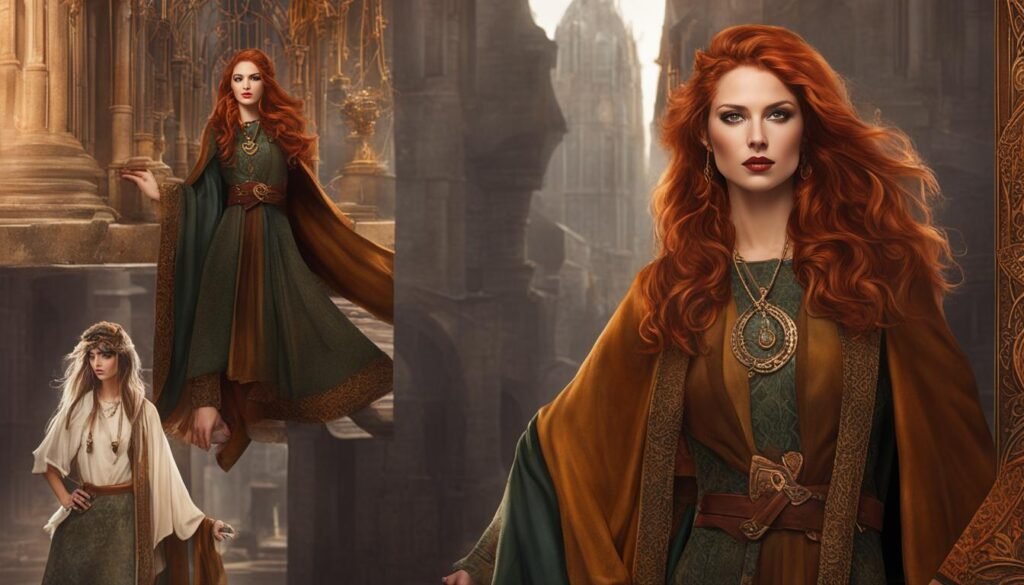
Brigid’s captivating mythology and multifaceted nature have had a significant impact on popular culture. Her presence can be felt in various forms, including novels, role-playing games, and musical tributes.
Novels:
One notable novel that features Brigid is Heather Terrell’s “Brigid of Kildare.” This enchanting book masterfully intertwines the stories of both the goddess and the saint, showcasing Brigid’s enduring legacy and the timeless appeal of her tale.
Dungeons & Dragons:
Brigid also holds a prominent place in the popular role-playing game, Dungeons & Dragons. In the game, she is often referred to as Brigantes, a powerful figure with connections to the realms of wisdom, poetry, healing, and protection.
Songs and Poems:
Artists inspired by Brigid’s myths and significance in Celtic culture have dedicated songs and poems to celebrate her. These artistic tributes capture the essence of Brigid’s diverse aspects, from her role as a muse for poets to her healing and protective qualities.
Brigid’s influence in popular culture not only highlights her importance in Celtic mythology but also serves as a testament to the enduring fascination with her character.
Conclusion
In Celtic mythology, Brigid holds a significant place as a revered figure embodying wisdom, poetry, healing, protection, and craftsmanship. Her enduring legacy is evident in the traditions, symbols, and sacred sites associated with her.
Brigid’s multifaceted nature as a goddess represents the various aspects of the divine, bridging the realms between different domains of life. She continues to inspire and captivate people today, extending her influence beyond mythology.
From the sacred wells dedicated to her healing properties to the Brigid Cross hung for protection, Brigid’s significance is deeply rooted in Celtic culture. Her presence and influence in Celtic mythology exemplify the enduring power and impact of ancient beliefs and storytelling.
FAQ
Who is Brigid and what is her significance in Celtic mythology?
Brigid is a revered figure in Celtic mythology and is associated with wisdom, poetry, healing, protection, smithing, and domesticated animals. She is a member of the Tuatha Dé Danann and is believed to be the daughter of the Dagda. Her significance lies in her multifaceted nature and her role as a bridge between different realms and aspects of life.
What is Brigid’s role in Irish mythology?
Brigid is a goddess of pre-Christian Ireland and is part of the Tuatha Dé Danann, a supernatural race in Irish mythology. She is the daughter of the Dagda, the chief deity of the Tuatha Dé Danann. Brigid’s domains include wisdom, poetry, healing, and protection. She is associated with the sun and fire, and is often depicted as a fiery-haired goddess.
How does Brigid’s triple aspects and domains reflect her importance in Celtic mythology?
Brigid is often described as a triple deity or as having three sisters with the same name. Her triple aspects represent wisdom and poetry, healing, and smithing. As a goddess of wisdom and poetry, she is revered by poets and is believed to inspire creativity. As a healer, she possesses the knowledge and skill to bring about healing and is associated with sacred wells. As a smith, she is a master craftsman and is connected to the art of blacksmithing. She is also associated with domesticated animals and is considered their protector.
Is there a connection between Brigid and Saint Brigid?
Historians suggest that the Celtic goddess Brigid was later syncretized with the Christian saint of the same name, Saint Brigid of Kildare. This syncretism occurred when Christian monks grafted the name and functions of the ancient goddess onto the saint. Both Brigid and Saint Brigid are associated with healing, poetry, blacksmithing, and the arrival of spring.
What symbols are associated with Brigid and where can her sacred sites be found?
Brigid is associated with several symbols, including wells and the Brigid Cross. Wells dedicated to Brigid can be found throughout Ireland and Scotland, and are believed to possess healing properties. The Brigid Cross, made of rushes or grass, is a traditional symbol associated with Brigid and is often hung above doorways for protection. Sacred sites dedicated to Brigid, such as Brigid’s Well in Kildare, attract visitors seeking her blessings for healing and inspiration.
What is the origin and meaning of the name Brigid?
The name Brigid is derived from the Old Irish Brig, which means “exalted one” or “high one.” This name is believed to have originated from the Proto-Celtic word Briganti, which is associated with the ancient British goddess Brigantia. The name is also cognate with Old High German and Sanskrit words meaning “high.” The association with the Hindu dawn goddess Ushas suggests a possible connection to ancient dawn goddesses across different cultures.
Who are Brigid’s family members and mythological connections?
Brigid was the daughter of the Dagda, a prominent figure in Celtic mythology and the chief deity of the Tuatha Dé Danann. While the identity of her mother is unclear, some sources suggest she may be associated with the goddess Danu, the namesake of the Tuatha Dé Danann. Brigid had several siblings, including Aengus, Midir, Bodb Derg, Cermait, and Aed. Her connections to her family and other mythological figures highlight her importance in Celtic mythology.
What is Brigid’s role as a bridge in Celtic mythology?
Brigid is considered a bridge between humankind and the otherworld in Celtic mythology. She is associated with sacred sites and is believed to have been called upon by the druidic cults for various purposes. Brigid’s role as a protector is evident in her associations with fire and healing, as well as her connection to domesticated animals. Her imprint can be seen in the numerous sites dedicated to her scattered throughout Ireland.
How would you describe Brigid’s attributes and dichotomy?
Brigid is characterized by a dichotomy of attributes. She is both a fire goddess associated with passion and fertility, and a protector associated with healing and domesticated animals. As a goddess of poetry, she inspires creativity and is revered by poets. Her ability to heal and bring about transformation is also emphasized in her mythology. Brigid’s multifaceted nature makes her a complex and influential figure in Celtic mythology.
How has Brigid influenced popular culture?
Brigid’s influence can be seen in various aspects of popular culture. She has been featured in novels, such as Heather Terrell’s “Brigid of Kildare,” which combines the stories of the goddess and the saint. Brigid is also a prominent figure in the Dungeons & Dragons role-playing game, where she is often referred to as Brigantes. Additionally, songs and poems dedicated to Brigid celebrate her different aspects and capture her significance in Celtic mythology.


